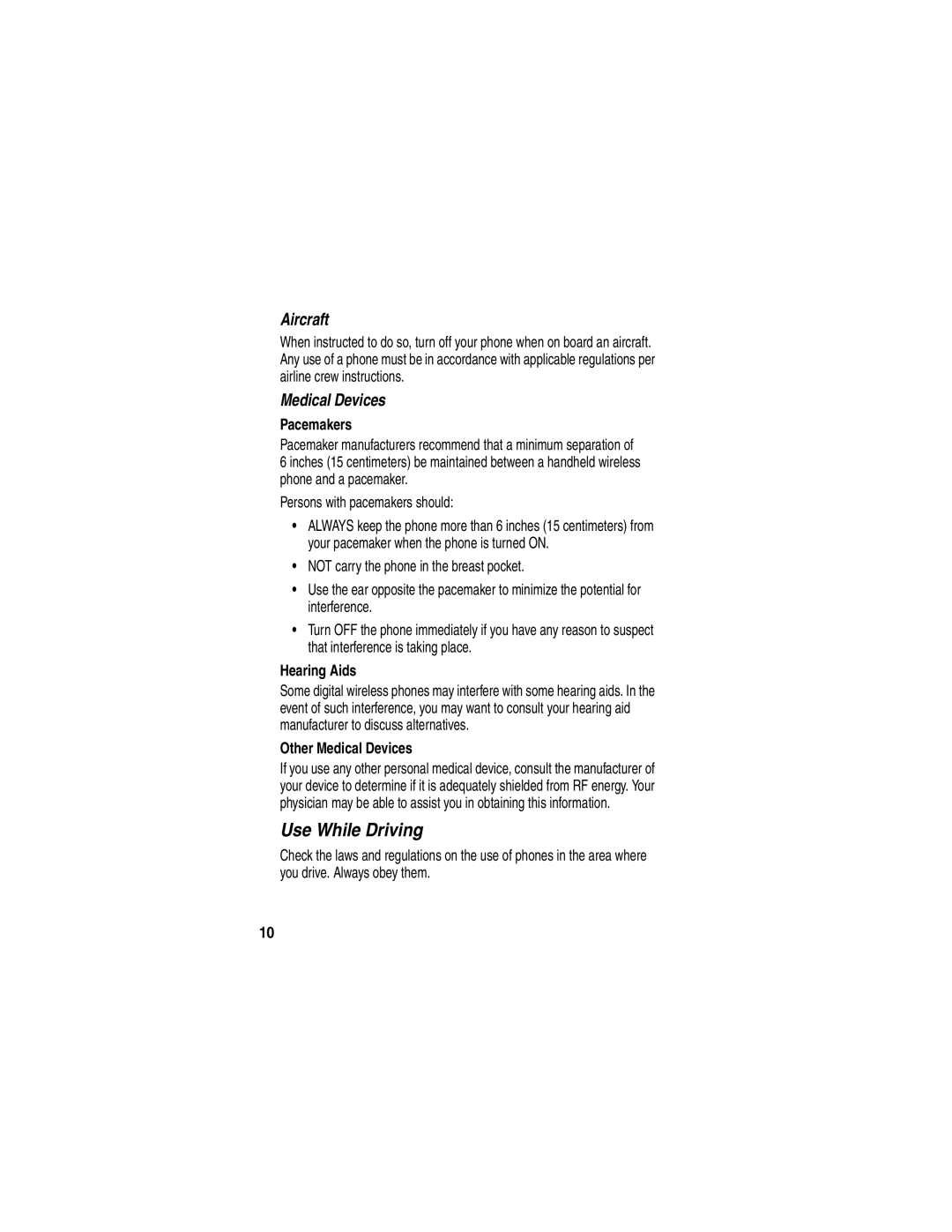Menu Key
Connector Port
Welcome
Send Key
Check It Out
Message
Send
Multimedia
Read
Motorola, Inc
Motorola, Inc Consumer Advocacy Office
United States
Software Copyright Notice
Contents
Dialing International Numbers
Setting a Screen Saver Image
Changing the Active Line
Returning an Unanswered Call
Consumer Information on
Exposure To Radio Frequency RF Energy
Operational Precautions
External Antenna Care
RF Energy Interference/Compatibility
Aircraft
Use While Driving
Medical Devices
Potentially Explosive Atmospheres
Operational Warnings
For Vehicles With an Air Bag
Blasting Caps and Areas
Batteries
Seizures/Blackouts
Chargers
Repetitive Motion Injuries
Take a minimum 15-minute break every hour of game playing
Getting Started
Optional Features
Optional Accessories
About This Guide
Installing the SIM Card
Battery Use
Getting Started
Installing the Battery
Charging the Battery
Turning Your Phone On
Adjusting Volume
Turn off an incoming call alert
Keypad keys Dial the phone number Make the call
Making a Call
Answering a Call
Tip You can also close the phone flip to end the call
Viewing Your Phone Number
Find the Feature
Highlight Features
Taking and Sending a Photo
Active viewfinder
Point the camera lens at the photo subject, then
View storage options
If you choose to store
Sending a Multimedia Message
To add another slide to
Contents for the new slide
Insert the file
To send the message, go to
Receiving a Multimedia Message
Highlight Features
Learning to Use Your Phone
Using the Display
See page 1 for a basic phone diagram
Message Recent Calls s à Browser
Midlet
Battery
Java
Strength
Call
= alarm activated
= secure packet
CSD call
Learning to Use Your Phone
Key Use the 5-way navigation
Using the 5-Way Navigation Key
Performs the same function as the right soft key +
Using Menus
End Key Left , or right
Selecting a Menu Feature
Find the Feature M Recent Calls Dialed Calls
Selecting a Feature Option
Entering Text
Below to set
Setting Up a Text Entry Method
Choosing a Text Entry Method
See below to set
= no capital letters
Using Capitalization
Text Entry Method Indicators
= all capital letters Letter only
Using Tap Method
Store the text
Store text
After
Press OK + to accept
Press Sright to accept
Tap Method Text Entry Rules
Character Chart
? ! , @ & ~
Press Sright to highlight
Using iTAP Method
Press *to enter Prog and a space
Entering Words
Keypad keys Show possible symbol One press per
Using Numeric Method
Using Symbol Method
Symbol Display Sleft or right
Symbol Chart
Deleting Letters and Words
Setting Phone Ring Style
Using Smart Key
Using the External Display
Soft key +
Volume keys Scroll to Forward Smart key
Using the Handsfree Speaker
Adjusting Voice Call Forwarding
Volume keys Return to the home screen
Changing a Code, PIN, or Password
Locking Your Phone Manually
Locking and Unlocking Your Phone
Unlocking Your Phone
If You Forget a Code, PIN, or Password
Setting Your Phone to Lock Automatically
Recording a Voice Name
Using the Phonebook
Storing a Phone Number
Dialing a Number
Sorting Phonebook Entries
Setting Picture Caller ID View
Voice Dialing a Number
Viewing Entries By Category
Setting a Ring Style
Setting Up Your Phone
Setting the Time and Date
Storing Your Name and Phone Number
Setting Answer Options
Setting a Wallpaper Image
Set the delay interval
Setting a Screen Saver Image
Scroll to Delay
Confirm the delay setting
Adjusting the Backlight
Setting Display Brightness
Setting Display Color
Setting Display Timeout
Redialing a Number
Calling Features
Changing the Active Line
View the dialed calls list
Incoming Calls
Using Automatic Redial
Using Caller ID
To redial the phone number
Calling an Emergency Number
Turning Off a Call Alert
Outgoing Calls
Viewing Recent Calls
Dialing International Numbers
Select the list
Call the entry’s number
Scroll to an entry
Connected
View entry details
Returning an Unanswered Call
Using the Notepad
Attaching a Number
Calling With Speed Dial
Calling With 1-Touch Dial
Receiving a Voicemail Message
Using Voicemail
Listening to Voicemail Messages
Listen to the message
Keypad keys Enter your voicemail number
Storing Your Voicemail Number
Store the number
Using Call Waiting
Putting a Call On Hold
Phone Features
Main Menu
Settings Menu
Initial Setup
Feature Quick Reference
Calling Features
Use
Messages
Send Text
Template
Chat
Phonebook
View
Set
Category
Set Picture
Personalizing Features
Menu Features
Dialing Features
Call Monitoring
Handsfree Features
Timer
In-Call
Speaker
Power-Off
Delay
Phone
Personal Organizer Features
Network Features
Data and Fax Calls
Reminder
Set Alarm
Alarm
Turn Off
Security
News and Entertainment
Web
Download
Objects from
Sessions
With
Sounds
Edit Sounds
MotoMixer
Specific Absorption Rate Data
Page
Do wireless phones pose a health hazard?
What is FDAs role concerning the safety of wireless phones?
National Telecommunications and Information Administration
Page
What about children using wireless phones?
Page
Products and Accessories
What Does this Warranty Cover?
Provided for below
Connection Product
Exclusions
Consumer purchaser
Purchaser of the product
Who is Covered?
Software
What Will Motorola Do?
How to Obtain Warranty Service or Other Information
What Other Limitations Are There?
Page
Online Product Registration
Thank you for choosing a Motorola product
Wireless The New Recyclable
Index
100
Call waiting Caller ID 2, 23, 52, 59, 62
101
102
103
104
Sending 2, 22 taking 2
Passwords. See codes phone
International access code Redialing
105
Reference guide 14 right soft key
106
Speed dial
SIM PIN code changing 48 entering SIM PIN2 code, changing
107
108
Wireless Phone Safety Tips
109
Page
Wherever wireless phone service is available
111
112
Page
Motorola.com 8988485L61-O
